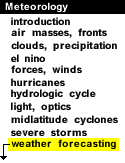
|
Climatology:
The Climatology Method is another simple way of producing a
forecast. This method involves averaging weather statistics accumulated over
many years to make the forecast.
For example,
if you were using the climatology method
to predict the weather for New York City on July 4th,
you would go through all the weather data
that has been recorded for every July 4th
and take an average. If you were making a
forecast for temperature and precipitation, then
you would use this recorded weather
data to compute the averages for temperature
and precipitation.
If these averages were 87 degrees with 0.18 inches of rain, then the weather forecast for New York City on July 4th, using the climatology method, would call for a high temperature of 87 degrees with 0.18 inches of rain. The climatology method only works well when the weather pattern is similar to that expected for the chosen time of year. If the pattern is quite unusual for the given time of year, the climatology method will often fail.
Analog Method:
The Analog Method is a slightly more complicated method of
producing a forecast. It involves examining today's forecast scenario
and remembering a day in the past when the weather scenario looked
very similar (an analog). The forecaster would predict that the
weather in this forecast will behave the same
as it did in the past.
For example, suppose today is very warm, but a cold front is approaching your area. You remember similar weather conditions one last week, also a warm day with cold front approaching. You also remember how heavy thunderstorms developed in the afternoon as the cold front pushed through the area. Therefore, using the analog method, you would predict that this cold front will also produce thunderstorms in the afternoon.
The analog method is difficult to use because it is virtually impossible to find a perfect analog. Various weather features rarely align themselves in the same locations they were in the previous time. Even small differences between the current time and the analog can lead to very different results. However, as time passes and more weather data is archived, the chances of finding a "good match" analog for the current weather situation should improve, and so should analog forecasts.
Numerical Weather Prediction:
Numerical Weather Prediction (NWP) uses
the power of computers
to make a forecast. Complex computer programs, also known
as forecast models, run on supercomputers and provide
predictions on many atmospheric variables such as temperature, pressure,
wind, and rainfall. A forecaster examines
how the features predicted by the computer will interact to produce the
day's weather.
The NWP method is flawed in that the equations used by the models to simulate the atmosphere are not precise. This leads to some error in the predictions. In addition, the are many gaps in the initial data since we do not receive many weather observations from areas in the mountains or over the ocean. If the initial state is not completely known, the computer's prediction of how that initial state will evolve will not be entirely accurate.
Despite these flaws, the NWP method is probably the best of the five discussed here at forecasting the day-to-day weather changes. Very few people, however, have access to the computer data. In addition, the beginning forecaster does not have the knowledge to interpret the computer forecast, so the simpler forecasting methods, such as the trends or analogue method, are recommended for the beginner.

trends |
|

Surface Features |




